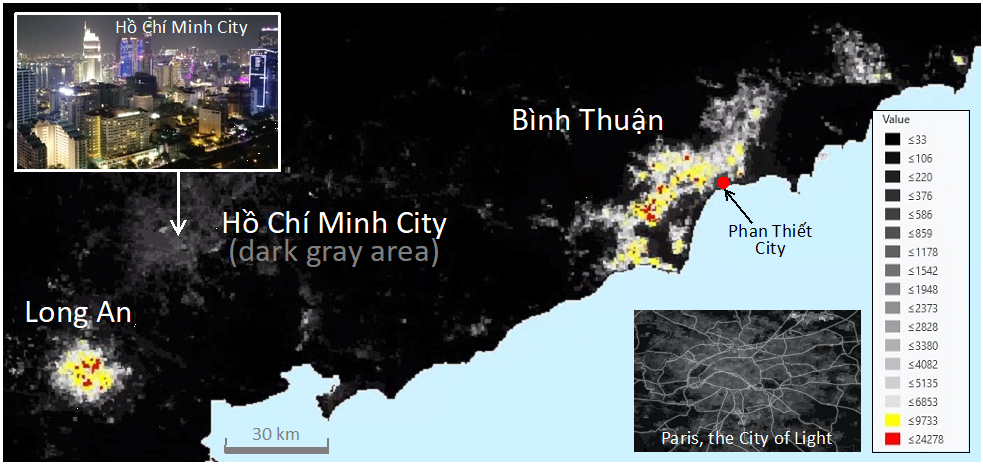Land Cover and Land Use Transformation and Impacts from Dragon Fruit Farming in Southern Vietnam
Son. V. Nghiem
Jet Propulsion Laboratory
California Institute of Technology
Pasadena, CA 91109, USA
Bình Thuận Province in Vietnam has been undergoing an intensive agriculture transformation by the development of extensive dragon fruit plantations, considered as the “Dragon Fruit Kingdom” (or the “Dragon Kingdom” in short). The dragon fruit farming in rural regions together with rapid urbanization due to the tourism boom in the city are creating the conditions for a dual rural-urban hotspot where both city areas and farmlands have been intensively and contemporaneously developed. Such transformation has profoundly altered the socioeconomic fabric of the region.

Figure 1. Visible Infrared Imaging Radiometer Suite (VIIRS) Day Night Band (DNB) image in February 2020. Lighting in the dragon fruit plantation regions in Bình Thuận and Long An [2] is much more intense than that in Hồ Chí Minh City (a mega city) or in Paris (known as the City of Light, inset image with same spatial scale and DNB scale). Inset photograph shows is Hồ Chí Minh City at night (taken by S. V. Nghiem).
Farmers in Bình Thuận use high-intensity artificial lights shinning up toward the dragon-fruit cactus canopy at night to drive the photoconversion process of phytochromes and increase the yield of dragon fruit production to multiple times per year (billion-dollar cash crop). The nighttime light (NTL) from regions of dragon fruit plantations is far exceeding in both extent and intensity compared to the NTL from Phan Thiết city (capital of Bình Thuận) that is rapidly urbanized by the tourism industry. In fact, Figure 1 shows that NTL from the Dragon Kingdom in Bình Thuận is brighter by far compared to NTL of Hồ Chí Minh City (a mega city) or to NTL of Paris (known as the City of Light) [1-3]. This leads to an extremely excessive overestimation of fossil fuel CO2 (FFCO2) emission currently using NTL as a proxy indicator of human settlements, which must be corrected to obtain accurate FFCO2 assessment to lend support to the Paris Agreement.
The case of Bình Thuận highlights a crucial significance for the Paris Agreement, a legally binding international treaty on climate change within the United Nations Framework Convention on Climate Change (UNFCCC) [4], which has to be fairly and correctly implemented, not only for Vietnam but also for many countries where extensive and intensive lighting is being used for agricultural activities in rural regions, rather than in cities that are major contributors to FFCO2 emission.
References
[1] Ngo, K. D., S. V. Nghiem, A. M. Lechner, and T. T. Vu, Building Structure Mapping on Level Terrains and Sea Surfaces in Vietnam, invited paper, Special Issue on Mapping Human-Settlements from, between, and beyond Remotely-Sensed Observations, Remote Sensing, 13, doi:10.3390/rs13132439, 2021.
[2] Jia, S., S. V. Nghiem, S. H. Kim, L. Krauser, A. E. Gaughan, F. R. Stevens, M. Kafatos, and K. D. Ngo, Extreme Development of Dragon Fruit Agriculture with Nighttime Lighting in Southern Vietnam, Book Chapter in review, Remote Sensing of Agriculture and Land Cover/Land Use Changes in South/Southeast Asian Countries, Eds. K. P. Vadrevu, T. L. Toan, S. Ray, and C. Justice, Springer, 2022.
[3] Nghiem, S. V., K. D. Ngo, A. Lechner, and T. T. Vu, Land Cover and Land Use Transformations and Impacts in Southern Vietnam, Invited, Abstr. GC35M-0849 presented at the 2021 Fall Meeting of the American Geophysical Union (AGU), New Orleans, LA, USA, 13-17 Dec. 2021.
[4] United Nations. The Paris Agreement. Available at https://unfccc.int/process-and-meetings/ the-paris-agreement/the-paris-agreement, accessed 22 May 2022.
Acknowledgments
The research was carried out at the Jet Propulsion Laboratory, California Institute of Technology, and supported by the National Aeronautics and Space Administration (NASA) Land Cover and Land Use Change (LCLUC) Program under a contract with NASA (80NM0018D0004).